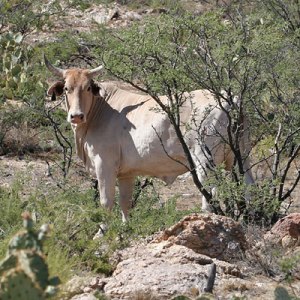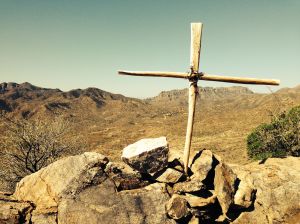Over spring break I visited my in-law’s home in Tucson, Arizona. One of the few planned events of my journey, besides to study by the pool, was an all-day dune buggy excursion to Montana Mountain with my father-in-law and his “Adventure Club” (actually, due to liability this was not an official Adventure Club event, rather a rogue pack of off-roading seniors with a penchant for danger). The mountain sits at the entrance to Tonto National Forest and, a bit further on, to the 700-mile Arizona Trail.
To be sure, my expectations of the journey included: a bumpy ride, a potential sunburn, a thick coating of dust and an awe-inspiring view. What I didn’t anticipate, however, was just how deeply affected I (a fully winterized, wholly urban Minnesotan) would be by the desert landscape and its inhabitants.

If you concentrate long enough, you can feel the dust
penetrate your soul

Aside from the rugged brush, Saguaro and Prickly Pear, buzzards and birds, life is subtle in the desert. The animals are there, but they don’t necessarily want you to know about it. Fortunately, March tends to be the time when the more elusive inhabitants come up for air, so I was able to spot fauna here and there. Javelinas, coyotes, scorpions, Gila monsters and jack rabbits are among the many species that thrive this time of year. On top of that, much of the public ranch lands are home to wild cattle – cattle so hearty that thorny cacti often constitute their dinner.

http://fireflyforest.net/firefly/2005/06/18/range-cattle/
Within a few minutes of the ride, we sped past a rattlesnake who was sunning itself in the middle of the trail. I wondered if it knew, or cared, that a cavalcade of “recreational vehicles” was hurdling towards it, whose beastly tires were poised to do real damage to any object in its way.
The sight of the snake soon led me to a deep admiration for my surroundings. There isn’t much to do as a passenger in a dune buggy, and in fact, right there on the dash an unsympathetic decal instructed me to:
Get In!
Sit Down!
Hold On!
And Shut Up!
I did so happily. I watched the arched rock formations, the bone-dry tributaries, and the slow change from desert shrub to greener vegetation as we climbed further up into the mountains. The perpetual roar of the engine precluded any hope of any conversation. I was stuck with my thoughts, and all I could think about was how brutal everything looked, how unconcerned with the “sanctity” of anything; but more importantly, how beautiful and deserving of my respect.
******************************************************************************
When Along Came a Symbol
It took a few hours, but we finally reached Montana Mountain, a single peak on a big range. Our leader Joe — a man well into his eighties, I might add — brought us to a steep incline, a degree I didn’t realize dune buggies could handle. The treacherous incline led to a widening in the trail on the side of the peak, and the whole procession managed not just to ascend, but to perfectly align their vehicles on that little widening so that we could get out and climb the rest of the way.
I admit the view was spectacular, I duly admit the view became secondary to a bit of an epiphany I had when I reached the top, with the help of this:

What is it, really?
Anthropology instructors will often draw a cross, swastika, or other highly charged symbol onto the whiteboard to demonstrate the power of symbolism in creating the human experience. It’s a profound moment because in the classroom, on that objective stage, the symbol evokes something unique yet definitive, the connotative and denotative, social and personal.
But to find this out in the “natural world” was unlike anything I’ve experienced in the classroom. Instead of an instructor’s whiteboard, it lay against a backdrop which wasn’t intended to demonstrate anything to anyone: an indifferent stage. And how much more striking the symbol was in an environment that is devoid of social constructs. This scene, to me, felt like the answer to the age-old anthropology inquiry – what makes us human?
Our grandiosity, superimposed onto the top of a mountain that overlooks the dusty immediacy below.
I know, I know, there are some physical descriptors to set us apart from the animals . . . some, oh I don’t know, six or so distinct traits we have. Maybe our big brains. But to me, until a better one presents itself, my answer to the age-old inquiry can be found above.
*****************************************************************************
For our Purposes
The day before my Montana Mountain excursion, I visited the Arizona State Museum, and spent the majority of my time there perusing the giant exhibit, “Paths of Life: American Indians of the Southwest.” The museum trip in itself could make for its own entry, but there is one reflection I have on that experience which can’t be ignored here.
The first section of “Paths of Life” is a glimpse at the resilient Seri people of Tiburón Island in Sonora, Mexico. The Seri, prior to being fully assimilated (as so many were) into colonial society, had a vital relationship to the sea – many of the relics of their culture reflect this fact. For example, the seeds and fruit of Eelgrass (zostera marina L.) – an aquatic plant in great abundance – was not only a staple of the Seri diet, but the grass itself had certain medicinal qualities, was used to line baskets, sea-turtle shells and the roofs of houses.¹ To me, however, the most striking application of the plant was its use in children’s dolls. One was propped upright in a display case at the museum – a faceless little bundle of Eelgrass with a rounded limbs and head, draped in scraps of cloth. I was haunted.
As my material existence has always seemed to be extracted from obscure locales, produced in factories which span the globe and finally pieced together, it was poignant to see this simple doll whose constitution was local in the absolute sense, a shrine to a particular way of life that also linked its’ human owner to the natural world.
In effect, it linked this:
 AND THIS:
AND THIS: 
Obligatory Conclusion
There is catastrophic disconnect between the world built for-humans-by-humans and the static, unforgiving world – the world that will soon purge itself of us if we keep simultaneously exploiting/neglecting it to expand the former – and I don’t know if it’s a result of ignorance as much it is of hostility.
I think the real solution (if there is one) to the environmental problem is the reconciliation of these two worlds. There’s a palpable sense in “civilized” society that Earth has done wrong by us, that we seek to dominate it out of fear, if not disdain, and not just because it’s there for us to dominate.
This aggression toward the earth is, I think, often propagated by people who mistake either the subjugation, or the plain bad policies of-humans-by-humans for natural phenomena. For instance, famine and disease are often blamed on the cruelty of “mother nature”, when in fact, the recent scope and intensity of these tragedies are often the result of human behavior. For example, compulsory monoculture led to, just to name one, the Irish potato famine. Likewise, domestication, urbanization and other human patterns of behavior are largely responsible for the magnitude of illness we face today.
As is the case with another prominent issue that I won’t mention, “blaming the victim” (in this case, the earth and its non-human inhabitants) for the violence done unto it is suggestive of an inherent, baseless hatred. I believe it’s time we realized nature is not the enemy.
¹Richard Felger and Mary Beck Moser. Jul. 27, 1973. Eelgrass (Zostera marina L.) in the Gulf of California: Discovery of Its Nutritional Value by the Seri Indians. Science. New Series, (181,4097) p. 355-356






